#top ethernet switch
Explore tagged Tumblr posts
Text
How to Purchase Refurbished Network Hardware in the UK?

Understanding Refurbished Network Hardware
What is Refurbished Network Hardware? Refurbished network hardware includes routers, switches, firewalls, and other networking components that have been previously owned but restored to a near-original condition. Typically, these items are inspected, cleaned, repaired (if necessary), and tested to meet the original manufacturer’s specifications.
Why Opt for Refurbished Hardware?
Cost Efficiency The primary allure of refurbished hardware lies in its cost-effectiveness. Businesses can save up to 50–80% off the retail price of new equipment, making it an attractive option for cost-conscious managers.
Environmental Impact Choosing refurbished hardware server also supports environmental sustainability by reducing e-waste and the need for new materials in manufacturing.

How to Buy Refurbished Network Hardware in the UK
1. Identify Your Network Needs Before shopping, clearly define what you need. Consider the scale of your network, the types of devices you’re connecting, and the performance metrics crucial to your operations.
2. Choose Reputable Suppliers Opt for suppliers known for their stringent refurbishing processes. Suppliers should have positive reviews and provide adequate documentation, including the history of the hardware and details of any repairs or replacements done.
3. Verify Certification and Testing Ensure that the refurbished equipment is certified and thoroughly tested. Certifications from the original manufacturer or an accredited refurbisher are indicators of quality and reliability.
4. Check for Warranties and Return Policies A reliable refurbished hardware supplier will offer warranties, ranging from 30 days to a year. They should also provide clear return policies in case the equipment fails to meet your expectations.
5. Compare Prices Once you have identified potential items, compare prices across various suppliers to ensure you are getting the best deal. Remember, the cheapest option is not always the best; factor in warranty and support when making your decision.

Conclusion
Purchasing refurbished network hardware in the UK is an excellent way to save money while acquiring high-performance equipment. By following these steps and choosing your supplier carefully, you can ensure that you get reliable hardware that fits your needs without stretching your budget. Always prioritize quality, support, and warranty coverage to make the most of your investment in refurbished tech.
#buy network hardware in London#network switch in uk#best ethernet switch uk#network hardware vendors uk#refurbished hard drives uk#buy networking hardware#top 10 networking companies
0 notes
Text
Thoughts and opinion on Switch 2
Before I start, do know I really like tech and generally, I like interesting implemtations of it, so I do have a bias towards handheld consoles in general because they have much more interesting limitations to start with. I'll get all my thoughts, up and down, on the switch 2.
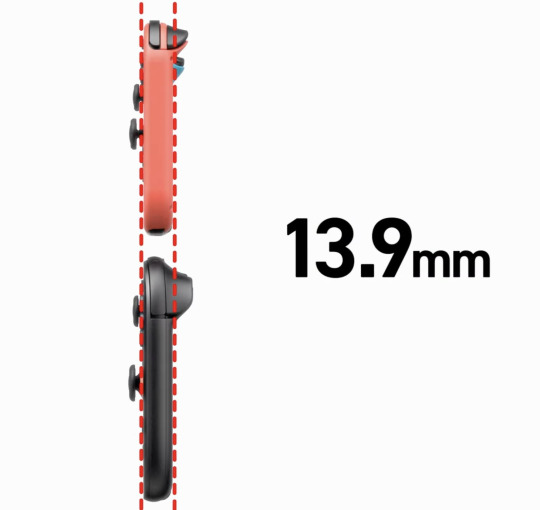
I know the bigger screen does mean more internal area to work with, but how the hell did they manage to keep the thickness nearly identical to the switch 1? Actually impressive, I desperately want to see inside if it is all just because of smaller chip size.
Ok, so where do I properly begin excluding the shock that they pulled off the same thickness? Oh, the screen!
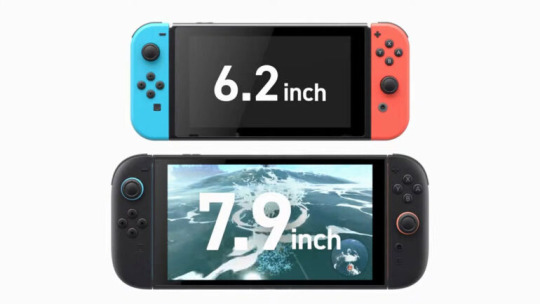
This screen is just a welcome addition overall. 1080p, better brightness and better panel tech that allows for HDR (Microsoft fix your god damn hdr implementation even nintendo has it) while being 120hz and VRR (Nvidia confirmed that it's using their implementation of g-sync via a blog post, here: https://blogs.nvidia.com/blog/nintendo-switch-2-leveled-up-with-nvidia-ai-powered-dlss-and-4k-gaming/). It now matches and slightly exceeds a lot of displays on handhelds now, which funnily enough makes puts it in a similar position as the og switch screen back in 2017, but at least the baseline is much higher so I think this will make the eventual OLED either be more meh, or more better in comparison. It may be closer to the meh side, at least with the first impressions I'm seeing on youtube and seen through my 2013 gaming monitor with clear faded pixels which is it's own issue if I do end up deciding to get a switch 2. Still +$100 I'm calling it. However, the fact it's 120hz natively means that you can now run games at 40fps without screen tearing because it's a clean divisable number of 120, with it looking noticably better then 30fps but not as draining as 60fps or above, which is going to help with more title's battery life. Speaking of Nvidia, let's talk a bit about that blog post.
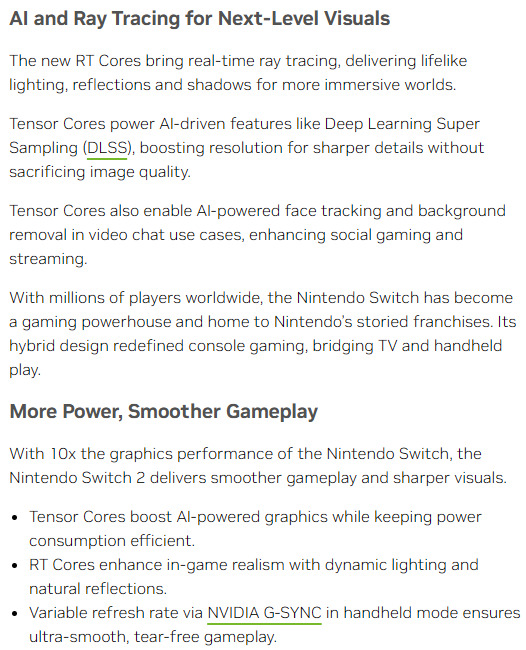
I do not know how much people like this or not (See recent RTX 40xx and 50xx launches to see how happy people are with Nvidia), but I think they are very much the ideal partners in crime with Nintendo this time around. As long as the Tensor hardware is power efficient enough as they claim, this will just be a boon for handheld gaming times, even if they're stuck at the same 2-6.5 hours as the launch model og switch. It also means it can be updated with time to improve games potentially, so if developers decide to take advantage of it and nvidia/nintendo makes it easy to just update the codebase of a game to get to a never version, we may actually have a case of games becoming more performant and/or better looking with time, assuming they are not running at native 4k already. That's neglecting the processing offloading for stuff like that goofy camera, microphone quality and other stuff
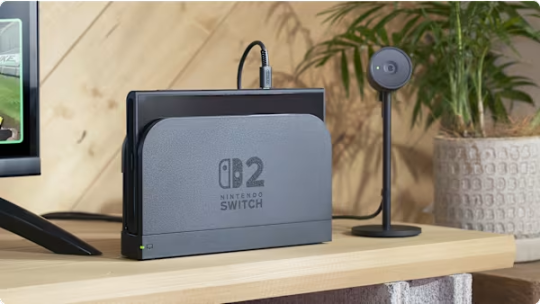
(seriously, if you got a recent enough Nvidia GPU try the Nvidia Broadcast app, it's does basically all the audio/video stuff nintendo showed recently, but now with a focused platform I think this is going to become excellent)
oh ya, it is odd that the stream from friend's framerate is like 12 fps, best guess there is because it uses the on board video encoder and decoded to handle it, and if each is a seperate channel, along with one for background recording/screenshots, plus whatever the games may need for their own dedicated use, I am not too surprised it got the cut on such a slim package. Suck though.
That leads into the dock.
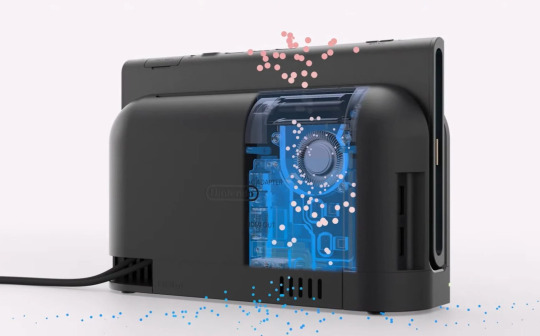
I think the dock is fine. Does the job, has USB ports on the side to connect controllers and charge them (USB 2 tho, so I guess the camera attachement had to go to the top USB C port CORRECTION, I just saw MKBHD's recent switch 2 impression video, it can actually be attached elsewhere maybe. That's interesting, Photo attached below). I think it's as inoffensive as the Switch Oled dock, which does all it needed to do too plus ethernet. It's fine.
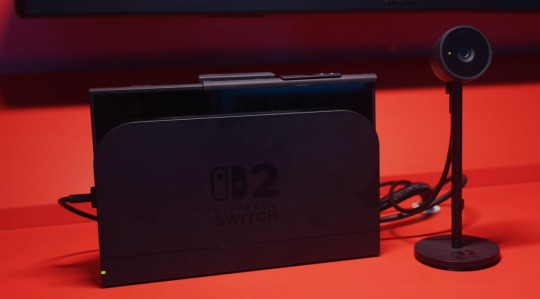
I guess while I'm here, let's touch upon the Microsd Express card slot.
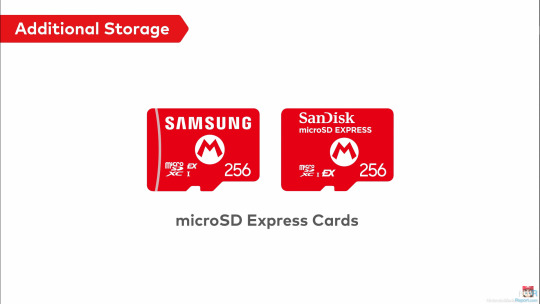
Let me preface this by saying, I knew that the standard was compatible with SD cards of prior so I found it odd they didn't make it clear if it could be used to at least get video/screenshots off, but they did!

Talking about the microSD express cards themselves, I may be in the minority here, but I am very very happy to see this get adopted. For those who are not in the know, it's basically much faster flash (that can be made for slightly more then an normal SD card) that runs off of the reader's PCIe Gen 4, allowing up to 2gb/s of read/write. Which is Crazy, and if they're mandating it to be required for games, that means the current 800mb/s read ones on the market right now is what the console will be using and games will finally load up so much faster. And, unlike the original SD cards, higher capacities like a terabyte already exist AND are not insanely more expensive over base sd cards.(I mean $20-25 for 256gb sd cards to $60 for same but microsd express is still a jump, but do you guys remember how fucking much 256gb sd cards costed originally? It was like $150, and I think 256gb storage will get further milage then the original 32gb storage the og switch had. And 1tb already cost $200 for when it comes out with the switch 2. Those prices will drop unless, uh... not within the scope of what I want to talk about)
Since we're on storage, 256gb of UFS storage? Like on phones, that can go multiple gigabytes per second read/write? Hell ya, we bout to get load times not much worse then other modern consoles.

Let's touch upon the joycons now.

I like them, but as more in a sense of improvment over og switch joycons. Which, honestly, that's all they needed to do. The standout weird feature is the mouse on both, but I only see this as a plus. I want more of my PC games on portable systems, and as much as I want the steamdeck too, the switch form factor is still more portable. Just... please let the bigger joysticks be actually good and resistant to stick drift, I do not want to open them up just to replace the sticks with hall effect ones again. As a plus, I can't wait to see what insanity warioware is going to become now.
Oh ya, chat.
Surprised it took them 2 decades to finally do it, but they seem to have a lot of restraint there still, with extensive parent controls to help metigate any issues, so I'll only give them slightly less shit. Slightly. I'm going to call it though, there is going to be controversy about what eventually will occur over the gamechat. Can't wait!
Switch online services
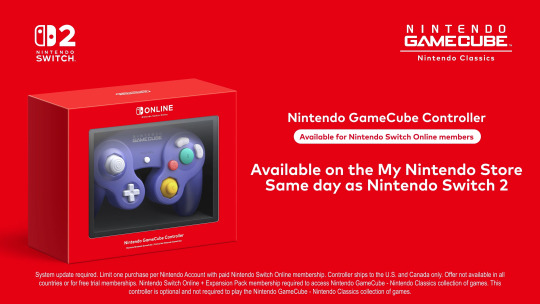
I mean, it was inevitable. This, with the Wii games that's almost absolutely coming later, is going to be good. I suspect a pricebump is going to occur with the NSO that's going to make it cost almost a full game per year, but at least the retro selection is going to start going from crazy to insane, making it probably worth it. I just hope that the voucher program (shown below) gets expanded to more third parties, because as much as I like nintendo games for $50 a piece with this program, it needs to be way more expansive to make the $20 cost at this time to be online, let alone get the 2 vouchers for $100, worth it. If they do that, and keep on adding new actually fun (looking at you Zelda Notes... what the fuck are you) and nice to have to the service, I think it could become worth it in the near future.
I ALMOST FORGOT ONLINE DOWNLOAD PLAY, seriously that alone may be worth it because with both local and online, it means you do not have to force your friends to buy games they may otherwise never touch outside of playing with you. This is straight up a good, pro-consumer thing if others don't ignore it 24/7. I just hope the streaming quality will not be dogshit ahhaha....

(Shout out to nintendo actuallly using this a part to prevent scalpers, I don't like it much because I didn't pay for NSO on the og switch but at least this is a verifiable way to prevent scalpers. I just wish acconts from the Wii U/3ds era got special treatment :^) )

Since we're getting more into software, shout out to how sad the UI is still.

Nintendo, the literal bare minimun here is not just black and white customizable themes. You haven't done that for a generation. I would have much rather had the UI present from the DSi/Wii to Wii U/3ds era then this bland nothing soup. God. Now, onto the most devicive one, and the one that makes or breaks it for me. The games, and their prices.
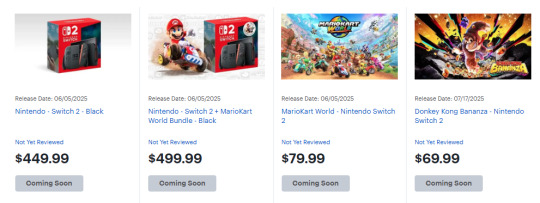
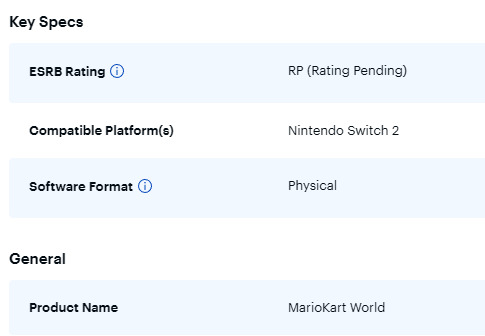
Let's get a few things clear, the $90 physical switch 2 game thing (which I had fallen for too) is in europe. If you're a suffering US citizen, the price is $80 for what seems to be big, high budget nintendo games, with everything else being $70, at least from the list of prices I've seen online.

About Game key cards, ya it's just the 'download play' games on the switch, but instead of a piece of paper that's one time, it's a re-usable cartridge that allows multiple downloads on other switches and acts like a physical one otherwise. This, in my opinion, is objectively better, and is not the default option. Other games will be on the Cartidge like og switch, see Cyberpunk 2077 on a 64gb one (seriously how the fuck they did that).

This switch 2 edition is on a case by case basis, so if it is just an fps/resolution bump, it is likely to be free. If it has a bit more, like some added extras and they know people would pay for the fps/resolution, see botw and totk will be $10, and if the content has basically DLC + all of the above, it's $20. Also, lol at welcome tour.
Seeing all of that, I'm iffy. I'm worried that the panic and reactions from everyone will lock the prices for everyone else at $80 since the publishers will take any chance to push prices up further, but if $70 stays I would reluctantly accept it. Unlike some people on the other platforms may say, in the past before $60 standardization, we had other options to play games like with rental stores, actually being around friends, and frequent discounts and bundles to get inventory moving. That does mean nowadays, especially with no sale nintendo, this price is here to stay, and if this is the cost to actually keep games good and not need astronomical sales to make back development costs, so be it. I am just not happy knowing that a lot of publishers will be using machine created/generated stuff each year for that price or $80 and expect no issues with it. The only thing I am very curious about is the capabilities of the switch 2 being somewhere between a PS4 and PS5, but able to handle PS5 ports, potentially making it the best way to play a lot of newer games on the go until valve decides in 2030 to make the steam deck 2.
Now everyone's favorite issues, price. I think it's reasonable, sucks a bit but reasonable. We're now dealing in a world where Nvidia has their focus on AI stuff, and knows that Nintendo wants backward compat + better stuff, so Nvidia likely is changing way more on parts. This world also includes inflation (seriously, $300 in 2017 is now closer to $400, and now there's all the extra nicer stuff slapped on top to justify a next gen). This world also includes ungodly uncertienty because of a a group in the wrong place in the wrong time. Considering all of this, honestly, $450 is fine. It sucks, I know it has pushed a few friends out from buying it w/o someone assisting them in the purchase, but it's fine. It's going to be a great refinement, which is all a sequel console had to be. The thing you have to know, nintendo is doing the thing again with previous controllers being compatible with the current system, so in reality (especially with me and my hall-effect modded controllers) the price to play with others will not be much more. I touched upon this already, but the game prices are iffy for me, and it's absolutely going to prevent me from buying as many games as I had for the og switch, but it's an dampener.
I will need more time to simmer (and see how my finacial situation is going to be), but I am currently leaning to I will try to get it. I'm on the fence, and I have a good chance of flipping to waiting later, or just not getting.
I may add more thoughts as I think them and remember I can use tumblr like this, but I think this is everything I wanted to get out that has been simmering in my head for a bit. Oh ya I almost forgot the most important thing, Homebrew. I love homebrew, it has given me extra life and enjoyment out of my og switch. If there is another launch edition vuln that allows homebrew, I want in.
16 notes
·
View notes
Text
TMAGP 35 - Terms and Conditions Spoilers
Reactions and theories
Reactions:
So Alice is doing some computer stuff? Ethernet involves the internet... Is she trying to see what Fr3D1 is doing? "Friend of mine used one to set up a podcast" GEORGIE????
So the Institute WAS exploring Alchemy? Keep on investigating, Celia!! ooo, what did you find? Norris!
Mr. Terrance Menke = inmate
Mr. Obadiah Quint = chair
Dr. Lynsey Harris = Psychologist
Mr. Allen Stolas = Rehabilitation, independent
Ms. Felicia Ross = Menke's defense
Ms. Chloe Leahy = Prosecution
Xana Beard = Victim Support
Connors Katsuj = Parole Officer
Mrs. Rune Laverne = stenographer
That's a lot of people...
He doesn't want parole????
MR. BONZO CAN WRITE???
He worshipped Bonzo as a god???
So Bonzo/the suit corrupted him? Like a slaughter/stranger/corruption cross?
Ohhhh, this is the guy that did the Bonzo murders...
The dude pissed off Bonzo )): MR BONZO'S ON HIS WAY HE WANTS TO STAY HE WANTS TO PLAY
He REALLY pissed off Bonzo ))):
So he's hinding from Bonzo now.
THE MUSIC IS BONZO'S THEME OMG YOU DIDN'T TELL YOUR LAWYER?????
....did he have a crowbar?? Or did Bonzo come?
"Like darkness or disease or being buried alive or something?" CELIA??
IS CELIA GOING TO NAME THE FEARS??
Balance the books? LIKE THE LAW OF EQUAL EXCHANGE?
William Price? hmm...
No, Gwen's right!
TEDDY!!!! Out of date tech for the new job?
GLITCH AT "IT'S FINE"!! I found one!!
Teddy works for FR3D1????????
Theories:
Not a theory but the fact that Celia keeps dropping TMA lore has me gnawing at the bars of my cage (/pos)
As for the casement, my art therapy/psychology (in the works) degree wants me to write off the initial childhood stuff as psychosis. Menke noted that Bonzo was there when his father "...lost his job, singing on the radio when things got worse, watching from the billboard outside when mum topped herself…" and that he used to pray to him. Assuming that Menke was a child during this time, it would make sense for him to associate the positive with Bonzo and almost worship him, in a "playing pretend" way (similar to how he said his dad used to pretend to go to church). I do think this could have developed into psychosis, specifically delusions (similar to a grandiose complex, but not quite as extreme). However, the cards as we know, were real, so we can't really say if the entire childhood experience was psychosis.
That aside, the fact that Dickerson fired back at Menke in order to hide the fact that Mr. Bonzo's MO was stolen by a superfan is kind of funny to me. Like, he had the chance to escape, even if it was into psychiatric care (not to say it was a good option). He found Bonzo the lesser of the two evils, and chose him, perhaps in hopes that he would change.
The Bonzo theme song playing as Menke prepared to attack makes me think that Bonzo works more like the Slaughter knife from last episode? Menke initially killed several people IN the Bonzo suit, mentioning that it felt like it got tighter. Maybe watching Bonzo so much as a child influenced him in some way?
As for William Price, I remembered his name and found it in TMAGP 20 - Social Stigma, when Sam got those anonymous emails (not from Jon):
"But I had an email when I got in tonight. It contained a bunch of files from 1999. Some… paperwork between Starkwall, or GSR Security as they were back then, and William Price, who used to run the response department. The documents were very thorough, and what wasn’t redacted was pretty clear. They totalled the Institute."
The "balance the books" factor makes me think of two possibilities:
"Balance" is the key: Basically, "books" is just a cover for something bigger, in case someone got Lena's job for some reason (*cough* Gwen *cough*) or if someone went snooping. The Institute wanted to make a world where ONLY "good" could exist. Perhaps whoever the OIAR is working for is trying to counter that. Instead of trying to switch everything to "good" or "bad" the OIAR keeps everything in check (with the help of Starkwell, and later, the Externals). Maybe Lena broke away from Starkwell because they were disrupting the balance with ulterior motives. Or perhaps by using the Externals who are under the (presumed) Fears, that itself maintains a sort of balance.
Focus on "books:" While the law of equal exchange has a place here, it's more similar to Leitner's in TMA. Maybe these books will be Issac Newton's lost research?
While both of these could happen, I think number 1 would be more interesting, and I know from the Season 1 Q&A that Johnny and Alex said they wanted to add references for old fans, but not directly copy TMA.
As for Teddy, his job has to be either with Starwell or Lena's superiors. I don't think he's directly working with Fr3D1, but he is clearly serving something. Perhaps he's not actually serving Fr3D1, maybe it's Augustus (and if Augustus is Jonah...). I know I've already theorized that Augustus (Jonah Magnus) is manipulating Gwen so that he can do something similar like he did with Elias, and that he is building a new body through Fr3d1, but what if he has multiple plans? It would be on character for him to have many fail-safes, so here is what I think: 1) His initial plan was through Gwen, and he was the one who set up those emails with Lena's "digressions."
2) Once Colin had his whole "attack Fr3D1" thing, he took advantage of that opportunity to begin storing chemicals to build a new body.
3) At the same time, whoever Teddy is working for, was building Fr3D1 a mechanical body, in hopes of using it in a Protocol or Ritual.
No updates on the Bingo Card. I'm trying to be strict, so I'm not marking off "Celia and Alice investigate the Institute" just yet.
Also, I miss Lena. I hope she makes an appearance soon (and is safe).
#tmagp#the magnus protocol#tmagp spoilers#the magnus protocol spoilers#celia ripley#alice dyer#gwendolyn bouchard#gwen bouchard#teddy vaughn#sam khalid#samama khalid#TMAGP 35#TMAGP 35 spoilers#theories#reactions#colin becher#mr bonzo#ghost and tmagp
19 notes
·
View notes
Text
Top 5 Must-Have Accessories for Every Electrical Panel

An electrical panel is the nerve center of any low-voltage power distribution system — responsible for delivering electricity safely and efficiently to various circuits. While the breakers and busbars often take the spotlight, it’s the accessories that enhance functionality, safety, monitoring, and reliability. Whether you’re an OEM, panel builder, or facility manager, equipping your panels with the right accessories can make all the difference.
In this article, we explore the top 5 must-have accessories for every electrical panel, based on industry best practices and real-world applications.
1. Cable Ducts and Trunking Systems
Purpose:
Cable ducts (also called wiring ducts or trunking) are essential for organizing and routing internal panel wiring. They prevent clutter, minimize the risk of short circuits, and make future maintenance more manageable.
Key Benefits:
· Improved safety through wire separation and insulation
· Neat, professional layout that meets electrical standards
· Ease of troubleshooting during inspections or servicing
Common Types:
· Slotted PVC ducts
· Halogen-free wiring ducts (for safety-critical environments)
· Flexible ducts for tight corners
Pro tip: Always select ducts with sufficient space for future cable additions — typically 20–30% free space is recommended.
2. Terminal Blocks and Marking Systems
Purpose:
Terminal blocks serve as connection points between internal and external wiring, ensuring a secure and modular setup. Combined with proper marking systems, they allow clear identification of circuits and functions.
Key Benefits:
· Safe and reliable wire termination
· Clear labeling for faster diagnostics
· Scalable for expansions and upgrades
Essential Variants:
· Feed-through terminal blocks
· Grounding terminals
· Fuse terminal blocks
· DIN-rail mounted marking strips or markers
Tip: Use color-coded terminals and labels according to IEC or local wiring codes for better clarity.
3. Panel Meters and Monitoring Devices
Purpose:
Modern electrical panels are not just passive distribution points — they are smart monitoring stations. Panel meters and current monitoring devices help track voltage, current, frequency, and power consumption.
Key Benefits:
· Real-time data for preventive maintenance
· Improved energy efficiency
· Quick response to load imbalance or faults
Popular Options:
· Digital voltmeters and ammeters
· Multi-function energy analyzers
· Load monitoring relays
Advanced choice: Consider smart monitoring units with Modbus or Ethernet communication for integration with BMS or SCADA systems.
4. Control and Signaling Devices
Purpose:
Control and signaling accessories like push buttons, selector switches, and pilot lights are critical for human-machine interaction. They allow operators to control, signal, and monitor operations within or from the front of the panel.
Key Benefits:
· Improved operator control and feedback
· Quick visual status indication
· Enhanced safety through emergency stop functions
Must-Have Components:
· Illuminated push buttons (Start/Stop)
· Pilot lights (for voltage presence or fault status)
· Emergency stop buttons
· Audible buzzers for alerts
Best Practice: Use IP65-rated front-panel devices for industrial environments to ensure durability and resistance to dust and moisture.
5. Surge Protection Devices (SPD)
Purpose:
Electrical surges — whether from lightning or switching operations — can damage panel components or connected equipment. SPDs protect against transient over voltages.
Key Benefits:
· Prevents costly downtime and equipment failure
· Increases the lifespan of electronics and controls
· Meets compliance with IEC 61643 or UL 1449 standards
Selection Tips:
· Choose SPDs according to system voltage (230V/400V) and risk level
· Type 1 for external surge protection, Type 2 for internal panel protection
· Consider combined Type 1+2 for comprehensive safety
Smart move: Pair SPDs with monitoring modules to track surge counts and SPD health.
Final Thoughts
When designing or upgrading your electrical panel, these five accessory categories are not just optional — they’re essential. They improve safety, functionality, compliance, and operational efficiency. Whether you’re building panels for industrial, commercial, or residential applications, investing in high-quality accessories will yield long-term benefits.
At Daleel Trading, we supply trusted low-voltage switchgear accessories from leading brands like Civaux — ensuring your panels are equipped with components that meet international standards.
Ready to upgrade your panel accessories?
Contact us today to learn more about our product range or request a consultation with our technical team.
6 notes
·
View notes
Text
Things I do not understand about the design of my parents house
Bathroom
The shower head is mounted a foot too low. I'm around 5'10 and my eye level is right where the pipe comes out of the wall. (This is the case for every shower in the house) which means the water starts to hit you around your nipples
The toilet paper holder thing is in between the toilet and the tub and requires an uncomfortable reach, actually hard to use, and so no one does
None of the towel racks are within reach of the tub, there's one on the opposite end of the room and on the opposite side of the toilet
There is a fan - however it just vents into the attic - no actual vent was ever installed - also it's the scariest looking fan ever made, you can put your hand through it. The one downstairs was a complete afterthought, when we moved in there was just a random plug hanging out of the ceiling that went to the fan - which vents into the drop ceiling... of the basement
That's right the bathroom that's in a basement and has no window that can open and also used to have carpet in a house with no HVAC system has NO FUNCTIONAL VENT FAN
There is a window - it's just a regular window that faces the front lawn, so hopefully no one's out there. There's blinds on it, but they're mounted away from the window so you can still absolutely see in if you stand in the right spot
It has an absurd amount of countertop - not really a bad thing, but it's very overkill for a bathroom
The soap tile thing came off the wall and refused to be glued back on - so there's just a big duct tape patch there now
General
The entire downstairs is drop ceiling, yup like an office building.
On top of that the entire downstairs was originally only lit by single bulb fixtures, like for closets, just bare bulbs in a dark, damp basement - except bathrooms which were fluorescent lamps
The basement has a very uncomfortable hallway, it's about 3 feet wider than most hallways and is of course lit by one light bulb
There's a random angled wall here, so one of the rooms has a random angled wall for some reason
The house has TWO water heaters, a more common full size one and a smaller like half sized one. Guess which ones plumbed to the showers - that's right the small one, the big one is only connected to the kitchen sink, washer, and the nasty added on shower in the garage that no one has ever used.
Right - there's technically a third bathroom, it is IN the garage, i mean it's literally added on it's like a box that just juts out into the room. No one has used this bathroom as it is - like i said in the garage and thus smells of dust and mold and also there's no floor.
The floor plan is very odd, there's a BIG room and I mean big on both the first floor and the basement, and lots of tiny rooms, including the one my parents tried to move me too, which is quite frankly too small for a twin bed what you're supposed to do with a room that size I don't know.
There's no water filter of any kind here, not really a big deal, although the water is literally pumped out of the ground so uh sediment is in everything - like, the water filter for drinking has dirt in the top of it
The dust the downstairs of this house has dust like no other dust, the networking stuff is out in the garage where the dust is the worst, and it's killed 2 ethernet switches and a modem, it's this thick brown dust that - even though the house has been cleaned - will never go away
The deck - which is covered in plastic fake grass terf carpet and is nasty - is actually held up by a big iron rod that was clearly added much later than when the house was built, along with a much newer staircase
There's just a big gap in the wall on the side of the carport with a 5 foot drop - no one knows why it's there
Oh yeah also- the carport is on top of the garage - the garage is not accessible for cars, as it's on the basement level, so hearing a car roll ON TOP OF THE ROOM YOU'RE IN is really nerve-wracking
There were no lights of any kind originally installed in the back of the garage, it was literally permanently dark (the part under where the cars park btw
I mentioned the lack of HVAC - the house does has an oil-burning furnace - which smells of oil and makes a loud BANG every time it turns on and off
The stairs
The stairs don't really fit so there's no landing and instead there's a angled stair to rotate into the hall basically right across where the landing should be - I've tripped and nearly died on this a lot.
The stairs have only one light, at the top, which is almost impossible to reach to change bulbs, (you have to put a ladder at the top so you're at risk of falling down the entire stairwell if you fuck up) oh and this means the weird angled step is ALSO in the dark :)
The stairs extend out into the hall which is great for tripping over and dying on the concrete floor.
I'm living in the house of leaves
21 notes
·
View notes
Text
I am the entire IT department of this place.
I am Help Desk.
I am Sysadmin.
I am executive management. Mainly because both of my actual bosses (On-site General Manager and remote corporate overlord) have no hard technical background. I was a software engineer for 7 years before this. And holy shit the whiplash.
My formal title is "IT Operations Manager", but I have nobody to manage. It's only me. I have complete authority over the IT infrastructure and am spending like 30% of my time doing help desk work. One minute I am setting top-level security policy, and the next, I am using a knife to pry an ethernet cable out of a laptop because apparently using the plastic tab to pull it out isn't intuitive for everyone.
I have learned a hell of a lot in the last few months.
But the thing that inspired this post, that I really want to talk about, but am struggling to find people to discuss with...
If I am walking across the facility to deal with an issue, there's like a 30% chance that someone will walk up to me with another issue that I need to deal with. I haven't implemented a help desk ticketing system yet. Haven't had the space.
But if I happen to be exhausted or in a bad mood when I respond to them, they will be hesitant to tell me when things break. This makes my job worse. I am not THEIR manager, but I'm still one of the Top Brass in this place. It doesn't matter how soft of a person I actually am, the workers here still don't want to upset me, and will swerve the hell away from me if they think they might be.
Even if I didn't care about being liked and was totally Machiavellian about how I treat people at work, this is bad.
I've read so much about the emotional labor of customer service.
Turns out, management has emotional labor, too. Except here, nobody will tell me when I'm being unapproachable. And it's also nobody else's problem.
If I can't be consistently friendly to the people around me, they will be disinclined to communicate with me. If cracks in the infrastructure appear, I won't know until something catches fire.
I cannot safely express my frustration or even exhaustion to *anyone* here, without making my job harder, regardless of how good of a rapport I may have with them.
I am the only computer professional in the building. Even the most well-meaning instance of "He is tired and overworked, let's not put more on his plate" could keep me ignorant of an impending disaster.
The entire intranet got completely fucked because someone plugged both ports of an IP phone into the same dumb switch, and I was up until 3AM trying to figure out what the fuck happened and I still haven't had the space to properly research how to overhaul this place's hackjob of a network out of the stone age. But they don't want to bother me with silly shit like helping people move cubicles when the job I was actually hired to do was implement automation into this manufacturing process.
My Corporate Overlords swear that they are working on hiring me help. But maybe I'm not squeaky enough of a wheel to get some grease.
/rant
2 notes
·
View notes
Text
The Frustrating State of Splatoon 3

Splatoon 3 was among the best-selling games of last year, and if you read my top games of the year post you’d see that I ranked it relatively highly. In just eight years, Splatoon has gone from the strange new IP on the struggling Wii U to being a major franchise for one of the biggest game developers out there. Being right there from the beginning, it was a magical time as the game slowly came into its own. However, almost one year into Splatoon 3’s release, I find myself torn. While largely enjoying the game as much as I ever have with the past two entries, 3 in particular has some pretty glaring issues that is slowly but surely whittling away at my patience and desire to play at all. So join me as I vent a bit about the state of Splatoon 3.
THE NETCODE! IT DOES NOTHING!
When it comes to most Nintendo series, online play is an afterthought, if it has it at all. Generally speaking, the company has shown to be laughably out of date regarding their consoles’ online infrastructure and the online experiences of a lot of their big titles. So imagine the problems when it comes to designing a game like Splatoon that is predominantly an online experience. The first two Splatoon games had their share of issues but they were fun enough…but something went wrong with 3.

From day one of release, up until the time of writing, I have suffered countless connection issues and errors in Splatoon 3, far more than I had with the first two games combined. Now, to this game’s credit, there have been attempts to address certain issues that have plagued the series. Matches end in a No Contest ruling if someone disconnects early in a match, you won’t be assigned a loss if someone on your team disconnects, and people that disconnect frequently are not only assigned losses, but also can get penalized and timed out of playing. These are some great improvements…if the infrastructure for the game even worked. Splatoon 3 is one of only a handful of games on Nintendo’s updated in-house server system, and I have to imagine the developers were grappling with issues well into the game’s release and couldn’t quite smooth them out. It was extremely noticeable in the early days of the game’s release, and even after several patches that allegedly helped with matchmaking and connections, I still see issues frequently. I have pretty good Internet, and actually sprung for an Ethernet adaptor to have a wired connection with my Switch. I have rarely had issues in other games and yet I’ll still see random disconnections in this game…and then it has the gall to blame ME for it and put me in time out. Oddly enough, Splatoon 3 is pretty much the ONLY game I play currently that has any kind of punishment system for disconnections…and yet it’s also the most unstable game of the lot. Ironic, really.
Outside of people disconnecting, which isn’t always the game’s fault, there’s also the game’s matchmaking and lobbies. At first I was really thrilled with the game’s overhaul of lobbies and queuing for matches. In the previous games you’d be stuck watching a screen as people slowly filed in for a match, without much to do. Being able to now freely run around in a training room and try out your weapon while the game searches for players in the background is great! What is less great is when the game flashes a “communication error” or “one or more players disconnected” message and completely crashes the room. This happens so frequently that it’s rare I play more than one game with a given group of randoms. I have noticed far less issues when grouping up with friends, and I appreciate that it is far easier to play with friends in general here, but it still ruins the overall pacing of a game session with a lot of starting and stopping of matchmaking, whereas in Splatoon 1 and 2 I could get a faster series of matches after that initial wait.
I understand that online connectivity can have tons of variables in play. In fact, for a time this past April I had a number of online issues that took me quite a bit of time to solve. It wouldn’t be fair to expect a flawless experience every single time I boot up Splatoon 3 but even accounting for other people rage quitting or the Internet in general having some hiccups every now and then, the frequency of issues is still far too high. Even if the rest of the game was flawless, the simple fact that it just doesn’t WORK at times makes for a stain on the rest of the package. But of course there’s more to this game’s problems than this, so let’s move on.
DUDE, WHERE’S MY FLANK ROUTES?
Stage design is important in any shooter, but especially one like Splatoon, a game defined by the ability to ink and swim over any terrain. Each game in the series certainly has its ups and downs with stages, but I’m particularly disappointed with 3’s so far. I think it’s telling that my favorite stages in 3 are actually from the two previous games. There are a number of things at fault here, with the most baffling one to me being the decrease in verticality for most stages. Many stages are flatter, with less ways to get to higher vantage points. There’s also an increase in un-inkable terrain, especially regarding walls. By itself that’s not necessarily a bad decision if the developers just wanted to go into a different direction…but then why did they include new mechanics that are clearly based AROUND having more verticality? The Zipcaster special weapon is supposed to let you grapple around the stage, but on many stages the special barely has any impact. It’s like if you take Spider-Man out of New York City and see that his web swinging is far more ineffective when he doesn’t have giant skyscrapers around him at all times. There’s also the Squid Surge, a universal technique that lets you quickly shoot up inked walls, but most of the time it’s easy to forget it even exists because so few stages feel like they were designed with it in mind. Even the single player largely ignores the mechanic at times, which just makes me question why it was even included at all. It feels like the developers weren’t all on the same page here.
You could also apply that to the lack of alternate routes or flanking options in most stages. Many stages in Splatoon 3 are little more than straight shots to the middle of the stage, with it often becoming a bloodbath with no way to quickly escape. You have forced drops that make it difficult to retreat to higher ground, if not impossible. I think the stage that showcases this the most is Hammerhead Bridge, which is from the first game but has been so heavily altered it’s practically a different stage. The bridge is basically just one straight line, and as a result the stage is one series of chokepoints after another. Once one side breaks past the middle it becomes harder and harder for the defending team to force them out. Having an alternate route to get around this and flank them from behind would help alleviate the spawn camping that usually results on that stage, but they’re gone. With that in mind, Hammerhead is probably my least favorite stage in the game; matches just devolve into being the first team to push past the middle and lock the enemy down for the remainder of the match. Some stages are more open than others, but on the whole it feels like options are limited and more than ever it’s easier to be backed up into a corner. What is especially frustrating is that pre-release footage of stages like Eeltail Alley or Scorch Gorge showcase dramatically different layouts that were more open, and yet the final release leaves us with stages that drastically limit your approach to the other team. Clearly, plans changed during development.

(Stages like Mahi Mahi Resort saw drastic changes from Splatoon 1 (Left) to Splatoon 3 (Right), becoming smaller and flatter)
Now, Splatoon is a live-service game and there are constant changes and additions to be excited for, and to a degree the stage situation has gotten better. Stages like Manta Marina or Flounder Heights offer more vertical options and are mostly untouched from their previous games, though personally I’m not very impressed with most of the new post-launch stages. One aspect the developers seemed to be aware of was the power that certain ranged weapons had on some stages. Eeltail Alley and Mincemeat Metalworks could be completely locked down by a good Charger or Splatling if they claimed the middle bridge. After the 3.0 update though, signs and other objects were added to some stages to provide some cover and keep long-range weapons from having such an advantage though the changes feel more like a bandage over a larger problem with the stage design on the whole. The series has completely renovated older stages in the past and that might still happen with 3, but as it stands we’re nearly a year in without major changes. Time will tell on how well this matter is handled but for the moment there are some days I log in and see the stage rotation and just immediately close the game because I’d rather not deal with certain stages at all.
SALMON RUN: REMEMBER, YOU’RE HERE FOREVER
Salmon Run was one of the best additions to Splatoon 2, a unique co-op experience that clearly had potential to be built on in a future game. 3 definitely makes some good improvements. Having the mode available at all times for starters, and the ability to toss eggs a good distance forward is a game changer that would make it tough to go back to 2’s version of the mode. That said, other changes for the mode haven’t been nearly as welcome I find.
As a live-service game, Splatoon needs to find ways to keep players coming back for more. Players already earn rewards for playing in the mode, though it often only takes a handful of games before your bonus rewards dry up until the next shift starts. In comes the addition of the Xtrawave, and a chance to fight a King Salmonid if you’ve managed to clear all three normal waves. The Xtrawave is itself a fun challenge that can cap off a successful win-streak, without any penalties for losing. That said, the rewards for clearing Xtrawave feel very lacking for the effort you have to put in. Scales are awarded for participating in the Xtrawave, gaining more if you manage to defeat the King, on top of how high the hazard level is when the wave began. While finishing quicker with high hazard levels can net you more scales there is a hard cap on how many you can earn, not to mention good old random chance when it comes to getting the rarer silver and gold scales. In fact, if your hazard level is low enough it’s apparently just straight up impossible to get gold scales. So the mode pushes you to juice up that hazard level and play over and over and over again to get just a handful of the things…and when it comes to what you can trade them in for, you’ll be working your tailfin off to afford anything of value. There are some stickers and figurines for your locker, with cosmetic items like extra slop suit colors and even some gear you can wear in normal multiplayer, but there are some problems here. The prices are pretty absurd for how long it takes to build up any of the rare scales, and what’s more the game’s shop won’t even show you everything you can buy unless you spend some scales to “uncover” more rewards. It already takes forever to earn scales but you might be forced to buy things you don’t want just to uncover stuff you DO want…and then you’re right back to having to grind out and save up for more.
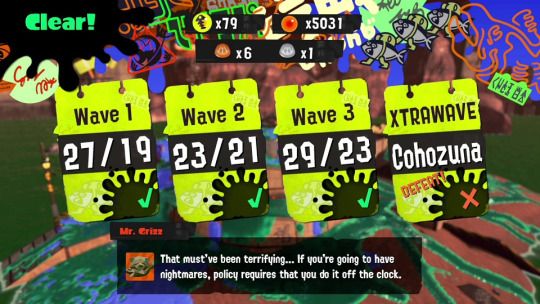
Really, “grind” is the perfect term here. This game expects you to devote a significant amount of playtime to get any form of reward, with very few ways to speed the process along. While it took them a bit to implement it, the new Big Run events do increase your scale rewards which is appreciated…but they are rare, happening at most twice in a season and only for about two days at a time. On that note, Big Run itself is an interesting idea, having the Salminids taking over a multiplayer map and pushing players to get as high of a score as possible to get a trophy. The Eggstra Work mode that was also added recently is somewhat related, having players go through five pre-determined waves in the push to get the highest score. The problem is that both of these modes only really reward the hardcore fans of Salmon Run, giving casual players few incentives to play along. The scores you need to get to even get a bronze trophy are fairly demanding for a more casual fan, and if you don’t care for score at all…there’s not much these can do for you. Splatfests at the very least grant you sea snails to further upgrade your gear, in addition to being a hyped-up event in-game centered on Turf War, the most beginner-friendly mode in the game. To be brutally honest, the continued focus on getting that score higher and higher has turned me off of Salmon Run in general. This, coupled with Salmon Run being just harder in general makes me more frustrated than anything else. Some shifts are just filled to the brim with enemies that start to mesh with one another and at times there’s so much going on the game actually starts to lag and slow down. If their intention was to keep me invested and want to come back to the mode, they managed the opposite, which is a pretty damning issue for a live-service game.
SEASONAL DROUGHTS
The success of Splatoon is largely tied to how Nintendo seemingly understood how to make a live-service continually appealing. While a full-price game, all further updates for multiplayer are free and often go for 1-2 years of the game’s life. Splatfests and other events ensure that there’s always a reason to come back later. The third game tries to change things up a bit regarding rewards and updates and honestly I think it mostly does a good job, though it isn’t without some downsides. In Splatoon 1 and 2 updates were typically weekly; every Friday or so you’d get SOMETHING new. Sometimes that meant a new weapon, or stage. Other times it might mean a completely new mode (more so in the first game). Splatoon 3 has instead adopted the season approach to content updates. Seasons last three months, and on day one of a new season players are given a ton of new things all at once. Roughly 10 new weapons, two new stages (so far the pattern being one returning stage and one brand new one), a balance patch and a new Catalog. Catalogs are effectively this game’s take on the Battle Pass that plagues so many other live-service games, though it’s mostly inoffensive. Catalogs have 100 levels to them, but pointedly cost the same amount of points to level up each time, and you get a huge bonus of points for your first win of the day. I think they serve as a decent, but attainable challenge to complete each season, without too much FOMO attached if you don’t finish them. That said, anyone that plays a lot of ranked tends to complete Catalogs quickly and then they don’t have much left to look forward to for the rest of the season.
Even if you’re not big on the Catalog, a growing sentiment with players is that the seasonal model isn’t enough to keep players coming back. All that new stuff at the start wears off before we’re even halfway through a season and the wait for the next season gets harder and harder to bear. These events like Big Run and Eggstra Work are clearly meant to help with that, though I’ve already detailed why I think these fall short. This game’s iteration of Splatfests have issues too. Going with three teams rather than two, on top of the controversial Tricolor Battles has resulted in a lot of complaints with each Splatfest, rather than excitement. Tricolor Battles were labeled as unfair to Defender players as early as the game’s pre-release beta Splatfest, and even after they were reworked slightly going into the first winter season, there’s been other issues. The Cryptid Splatfest ran into an issue where the vast majority of players picked either the Alien or Loch Ness Monster teams, with only 8% of players picking Team Bigfoot (at least in North America), meaning that the majority of players couldn’t earn points in Tricolor Battles, as they were thrown in with fellow Alien or Nessie players. And then there are the new Challenges, added with this past Sizzle Season.
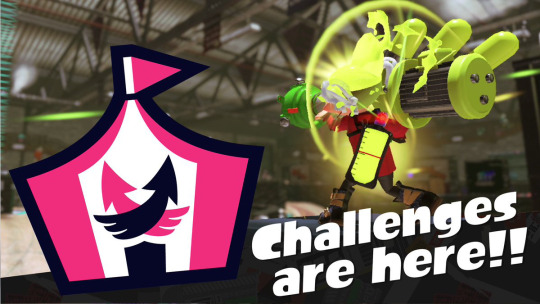
On paper, Challenges seem like a great idea. Wacky rule sets that give players another reason to turn the game back on, but again the execution is lacking. Challenges themselves occur irregularly with limited time slots. One challenge might start on a Wednesday evening from 10 PM to midnight, and the next time slot would be Thursday morning at 6 AM, as an example. If you aren’t available on that day or that specific time…tough luck. The whole issue of playing the game on its own schedule versus your own has existed since the first game, but stuff like this feels nonsensical. There’s also the fact that the rule sets vary, some being quite interesting, like fog rolling into a stage periodically, while others amount to playing one of the Ranked modes without sub abilities…which doesn’t really feel nearly as fresh. And the rewards for challenges are also fairly minor, getting badges if you place high enough (once again going the score-attack route) and if you get five wins you get…a free roll of the Shell-Out Machine. Yippee. All of this wraps back around to the same core issue in that I don’t think a lot of the content in Splatoon 3 really values the player’s time. Scheduled events are rare and you have little control over actually being able to participate in a lot of them, and the rewards just don’t feel worth the time investment, outside of the Catalog. Despite their best efforts to retain players, I fear they might actually just drive them all away.
CONCLUSION
To wrap things up here, I want to stress that I do often enjoy playing Splatoon 3 and I’m pretty sure I’ve managed to put way more time into it than the first two games combined at this point. The updates to mobility with the Squid Surge and Squid Roll feel great, the new main and special weapons are fun, visually the game continues to be fantastic and its single player campaign was a welcome improvement from the first two games. Splatoon 3 clearly benefitted from the developers having gained more experience with the previous two titles and there’s tons of overall polish and content packed into this game. As a live-service, it will also continue to change and by this time next year when the last of the planned updates will be finished, it very well might be in a better place.
I don’t like to be negative and just rant and rave without any amount of constructive criticism, and ultimately I want this franchise to continue doing well and improving itself. There’s nothing else on the market like this (we’ll see if Foamstars can holds its own I suppose), and as a fresh, new franchise for Nintendo the last thing I want is for it to crash and burn. Splatoon 3 in some respects feels like a worthy successor to the previous titles and does feature a number of positive changes and additions to the core game, but the issues are even more prevalent than ever and I really hope the developers take all of this into account with the next game, whenever that happens. Considering this game was developed at the peak of the COVID 19 pandemic, on an aging console that likely couldn’t match the developer’s ambitions, this could have come out far worse, and despite what the last 3000 words or so might tell you, Splatoon 3 is far from a bad game. It’s a good game, that at times can be great fun, just held back by a number of smaller issues that I’ve love to see addressed so this trilogy can end on a high note. Maybe in a year I’ll do a follow-up and see how things have changed, but for now I guess I’ve said my piece. Thanks for listening.
-B
2 notes
·
View notes
Text
[ID: A snail crawling on top of a stack of 2 blue Linksys routers next to a stack of three ethernet switches.]
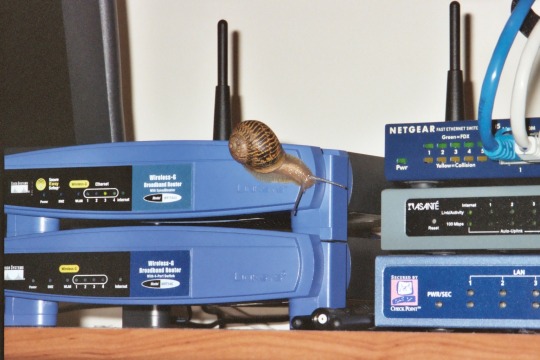
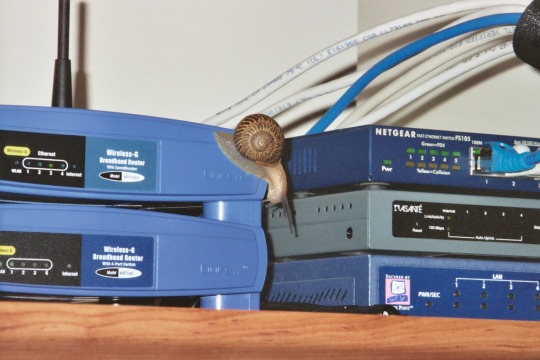
“Lettuce loves technology!” 2006
10K notes
·
View notes
Text
Price: [price_with_discount] (as of [price_update_date] - Details) [ad_1] Experience superior connectivity with the Sounce HDMI Cable, engineered for high-speed and high-quality performance. Capable of transmitting audio and video signals up to 4K at 60Hz with an impressive 18Gbps bandwidth, this cable is perfect for UHD TVs, monitors, and gaming consoles. Its built-in Ethernet support enhances your setup by allowing seamless internet connectivity and data sharing between devices, ideal for smart TVs and gaming consoles. Constructed from top-grade materials, the cable is built to endure with reinforced connectors that resist bending and breaking. Compatible with a wide array of devices such as Xbox 360, PS5, PS4, and Blu-ray players, it offers versatile connectivity options. All this comes at a budget-friendly price, making the Sounce HDMI Cable a top choice for those seeking exceptional value and high-performance connectivity. ✅【Certified HDMI Cable】 Sounce HDMI cable (1.5m/5ft) is fully certified and designed to deliver exceptional performance. It supports Dynamic HDR 10, Variable Refresh Rate (VRR), Quick Frame Transport (QFT), and Quick Media Switching (QMS), as well as enhanced Audio Return Channel (eARC), offering an immersive viewing and smooth dynamic detail experience for both visual and audio content. ✅【High-Resolution Support】 This version of HDMI to HDMI Cable supports higher video resolutions and refresh rates, including 4K and 1080P. It also fully supports 3D video display and is HDCP 2.2 & 2.3 compatible. Additionally, the cable is fully compatible with HDMI 2.0b/2.0a/2.0/1.4/1.3/1.2/1.1, ensuring versatile usage across various devices. ✅【High-Speed HDMI Cable】 The Ultra High-Speed HDMI Cable offers an impressive bandwidth of up to 18Gbps. Its 24K gold-plated HDMI male port and zinc alloy case guarantee exceptional durability. The cable's triple shielding structure provides excellent protection against interference, EMI, and RFI, ensuring a lag-free and uninterrupted visual experience. ✅【Wide Compatibility】 The HDMI Cable is highly compatible with numerous devices, including MacBook Pro 2021, TVs, QLED TVs, 8K UHD TVs, PS5, PS4, Xbox, laptops, PCs, DVD players, projectors, and more. Additionally, it is also compatible with the Steam Deck, although an adapter is required for use. ✅【What's Included】 With your purchase, you'll receive Sounce's HDMI cable, measuring 3 meters (10ft) in length. To ensure your peace of mind, we offer a 24-month product replacement warranty and friendly technical support. If you have any questions or need assistance with our product, feel free to reach out to us at any time. [ad_2]
0 notes
Text
💻 Data Center Interconnect Market Size, Share & Growth Analysis 2034: Powering the Cloud Age

Data Center Interconnect (DCI) Market is gaining remarkable momentum as businesses around the globe strive for faster, secure, and more scalable data transfer capabilities. DCI encompasses the technologies used to connect two or more data centers to ensure seamless communication and data exchange. With growing adoption of cloud computing, digital services, and edge computing, the need for robust, low-latency, high-bandwidth connectivity has never been greater. The market is built around key technologies such as optical networking, Ethernet, and software-defined networking (SDN), all of which help to optimize redundancy, disaster recovery, and workload mobility. In 2024, the market is valued at approximately $9.5 billion and is projected to reach $22.3 billion by 2033, reflecting a CAGR of 8.9%.
Market Dynamics
The driving forces behind the DCI market’s growth include the rising volume of data generated by IoT devices, increased reliance on cloud services, and the emergence of new applications that demand real-time data processing. Wavelength Division Multiplexing (WDM) remains the most dominant technology segment, accounting for nearly 45% of the market due to its high bandwidth and transmission efficiency. Following closely are Ethernet and packet-switching technologies, which are essential for flexible networking and rapid scalability.
Click to Request a Sample of this Report for Additional Market Insights: https://www.globalinsightservices.com/request-sample/?id=GIS20272
Simultaneously, sustainability is becoming a significant theme. Organizations are striving to reduce their carbon footprint by adopting energy-efficient data center operations. However, the market also faces certain restraints such as high capital expenditure, complex regulatory compliance, and a lack of skilled professionals. Security remains a top concern, with increasing pressure to prevent data breaches and comply with evolving global standards.
Key Players Analysis
The competitive landscape of the Data Center Interconnect Market is defined by a mix of tech giants and emerging innovators. Key players like Ciena Corporation, Cisco Systems, Huawei Technologies, Juniper Networks, and Nokia Networks are continuously evolving their offerings to meet the demands of cloud-native businesses. These companies are investing heavily in R&D to bring forth solutions that offer higher speeds, better security, and more flexibility.
Emerging players such as Nex Gen Networks, Quantum Interconnect, and Inter Connect Innovations are gaining traction by offering cost-effective, niche solutions tailored to regional needs. These newer entrants are also experimenting with AI and machine learning to improve network optimization and performance.
Regional Analysis
North America leads the global DCI market, fueled by robust IT infrastructure and the presence of major cloud providers and technology firms. The U.S., in particular, is at the forefront of adopting high-capacity interconnect solutions.
Europe follows as a strong market, bolstered by stringent data privacy regulations and initiatives toward sustainable data center infrastructure. Countries like Germany and the U.K. are making significant investments in next-gen connectivity.
Asia-Pacific is witnessing rapid growth, with nations like China and India investing heavily in digital transformation and data infrastructure. Increasing internet penetration and mobile usage are further fueling demand in this region.
Latin America and the Middle East & Africa are emerging as potential growth hubs. Brazil, Mexico, the UAE, and South Africa are taking proactive steps toward modernizing their data centers, making them attractive markets for DCI solutions.
Recent News & Developments
Recent developments in the DCI market highlight a clear shift toward intelligent, software-defined architectures. Key companies like Ciena and Cisco are leading innovations in SDN and AI-integrated interconnect platforms. Solutions are being designed not only for speed but also to accommodate green goals — offering better power efficiency and a smaller carbon footprint.
Pricing for interconnect solutions varies widely, ranging from $10,000 to $50,000, influenced by bandwidth requirements and technology sophistication. The ongoing focus on reducing operational costs and energy usage, combined with the growing use of automation and virtualization, is shaping the future of data center networking.
Browse Full Report : https://www.globalinsightservices.com/reports/data-center-interconnect-market/
Scope of the Report
This report provides a comprehensive outlook on the Data Center Interconnect Market, offering insights into market size, segmentation, growth trends, and competitive dynamics. It analyzes market drivers, restraints, and opportunities while exploring in-depth regional performance and key technological shifts. Covering both historical data (2018–2023) and forecasts up to 2034, the report evaluates major industry participants, emerging players, and their strategies, including mergers, partnerships, and product innovations.
Our extensive coverage also includes PESTLE and SWOT analysis, demand-supply dynamics, import-export evaluations, and regulatory reviews. It equips stakeholders with actionable insights to make informed decisions and capture new opportunities in the evolving global data ecosystem.
#dataecosystem #datacenterinterconnect #cloudconnectivity #opticalnetworking #digitalinfrastructure #sdn #aiinnetworking #iotconnectivity #greendatacenters #edgecomputing
Discover Additional Market Insights from Global Insight Services:
High Speed Cable Market : https://www.globalinsightservices.com/reports/high-speed-cable-market/
Advanced Semiconductor Packaging Market : https://www.globalinsightservices.com/reports/advanced-semiconductor-packaging-market/
Agricultural Lighting Market : https://www.globalinsightservices.com/reports/agricultural-lighting-market/
Air Quality Monitoring System Market : https://www.globalinsightservices.com/reports/air-quality-monitoring-system-market/
High-Speed Camera Market : https://www.globalinsightservices.com/reports/high-speed-camera-market-2/
About Us:
Global Insight Services (GIS) is a leading multi-industry market research firm headquartered in Delaware, US. We are committed to providing our clients with highest quality data, analysis, and tools to meet all their market research needs. With GIS, you can be assured of the quality of the deliverables, robust & transparent research methodology, and superior service.
Contact Us:
Global Insight Services LLC 16192, Coastal Highway, Lewes DE 19958 E-mail: [email protected] Phone: +1–833–761–1700 Website: https://www.globalinsightservices.com/
0 notes
Text
Top Features to Look for in a Card Payment Machine UK Providers Offer
Finding the right card payment machine UK businesses can rely on is critical in today’s fast-paced retail and service environments. Whether you run a high-street shop, café, salon, or mobile business, having a dependable and modern card machine ensures smoother operations and happier customers. With contactless, chip and PIN, and mobile wallet payments becoming the norm, merchants need to choose solutions that support all payment methods while offering robust performance. The UK market offers a wide range of card machines tailored to small businesses, large retailers, and mobile vendors. Choosing the right machine enhances service efficiency and builds customer trust.
Fast Transaction Speed Enhances Customer Experience
A fast card payment machine UK businesses use can significantly improve customer satisfaction by reducing queue times and ensuring seamless checkouts. Slow transactions not only frustrate customers but also risk damaging a brand’s reputation. In contrast, a card reader with rapid processing speed ensures quick authorisation, which is particularly important during peak hours or busy sales periods. UK retailers and service providers benefit greatly from machines that can handle a high volume of transactions efficiently. Speed is a key feature that helps businesses stay competitive and responsive to the demands of modern consumers expecting instant, hassle-free payments.
Look for Card Payment Machine UK Options with Contactless Support
Contactless payments are now a standard expectation, making it crucial to choose a card payment machine UK retailers trust that supports this feature. Whether it's through debit cards, credit cards, or mobile wallets like Apple Pay and Google Pay, contactless capability ensures quick and safe transactions. UK consumers have embraced this payment method for its speed and hygiene, especially post-pandemic. Card machines with tap-to-pay functionality provide a frictionless payment experience, boosting customer satisfaction. Businesses that adopt contactless technology signal modernity and convenience, helping them attract tech-savvy consumers and speed up transaction times at the point of sale.
Reliable Connectivity Is Essential for Smooth Payments
For any card payment machine UK businesses depend on, reliable connectivity is non-negotiable. Whether using Wi-Fi, mobile data (4G/5G), or Ethernet, stable connections ensure every transaction goes through without delays or failures. Payment interruptions can lead to lost sales, customer dissatisfaction, and poor reviews. Mobile traders, especially at markets or on-the-go service providers, require card machines that can seamlessly switch between networks for continuous uptime. Many UK card machines now offer dual-SIM or automatic network switching to mitigate downtime. Choosing a device with strong, consistent connectivity is a smart move for businesses wanting smooth and dependable payment processes.
Choose Machines with Strong Security Features
In a digital age full of cyber threats, a card payment machine UK companies trust must include advanced security measures. Features like end-to-end encryption, PCI DSS compliance, and secure PIN entry are essential to protect both business owners and customers. Many modern card machines in the UK offer tokenisation and fraud detection to safeguard sensitive data during every transaction. Using a machine with strong security not only protects finances but also builds credibility and trust. For UK merchants, especially those processing high volumes of transactions, investing in a secure card payment terminal is not optional—it’s a business-critical requirement.
Card Payment Machine UK Models Should Support Multiple Card Types
A versatile card payment machine UK merchants use should accept all major card types, including Visa, Mastercard, American Express, and even international cards. Customers expect to use whatever card they carry, and being unable to accept certain cards can result in lost sales. Additionally, with the rise of prepaid, gift, and loyalty cards, machines that support various card formats offer a competitive advantage. UK businesses that serve a diverse customer base—especially in tourist-heavy areas—must ensure broad card compatibility. Offering flexible payment options through one robust device keeps customers satisfied and operations running smoothly without payment disruptions.
Easy Integration with POS Systems Is a Key Benefit
Choosing a card payment machine, UK businesses can easily integrate with their existing POS (Point-of-Sale) systems, streamlining both payments and inventory management. Integrated solutions allow real-time syncing of sales, improved reporting accuracy, and faster checkout times. Many modern card terminals are designed to work with cloud-based and software-driven POS systems used in retail, hospitality, and mobile businesses across the UK. Seamless integration minimizes human error, boosts productivity, and offers valuable sales insights. This technological alignment is essential for growing businesses looking to optimise their customer experience while maintaining efficient back-end operations through a connected payment ecosystem.
Battery Life Matters for Mobile Card Payment Solutions
For businesses on the go, the card payment machine UK entrepreneurs choose must have a long-lasting battery. Whether you’re a market vendor, taxi driver, or delivery-based service provider, having a device that stays powered throughout the day ensures uninterrupted service. Many portable card readers in the UK now offer up to 8–12 hours of battery life, with some models supporting fast charging or swappable batteries. A card machine with dependable battery performance allows mobility without the worry of running out of charge mid-transaction. For mobile businesses, battery life is as critical as processing speed and connectivity.
Conclusion
Selecting the right card payment machine UK businesses can rely on involves more than just finding the cheapest option. It’s about balancing speed, security, flexibility, and integration capabilities to create a reliable payment solution tailored to your operations. UK merchants must consider factors such as connectivity, battery life, contactless support, and multi-card compatibility when choosing a device. With the right card payment machine, businesses not only improve efficiency but also enhance customer satisfaction and loyalty. As consumer expectations continue to evolve, having a high-performing, secure, and future-ready card machine becomes a vital asset for success in the UK market.
0 notes
Text
Top Benefits of Implementing ABB Freelance Solutions in Bangalore’s Manufacturing Plants
Modern manufacturing plants in Bangalore are continually seeking ways to boost productivity, increase reliability, and maintain compliance with evolving industry standards. One technology that has gained widespread adoption is ABB Freelance Solutions in Bangalore, a compact Distributed Control System (DCS) designed to offer DCS-level reliability with PLC-like flexibility. As automation advances further, integrating Robotic vision solutions in Bangalore alongside ABB Freelance can deliver even greater benefits. This article explores the key advantages of adopting ABB Freelance in manufacturing facilities and highlights how pairing it with robotic vision enhances operational excellence.
1. Cost-Effective Scalability
Traditional DCS platforms often come with high upfront costs and complex licensing models. ABB Freelance, however, provides a modular architecture that allows manufacturers to add control loops and I/O modules gradually, matching budget constraints and production growth. This pay-as-you-grow model ensures that plants only invest in the capacity they need initially, with the option to expand seamlessly. Over time, this translates to significant savings compared to monolithic DCS installations.
2. Rapid Deployment and Reduced Engineering Effort
One of the standout features of ABB Freelance is its intuitive engineering environment, which leverages the System 800xA interface. Preconfigured function blocks, drag-and-drop graphics, and standardized libraries simplify control logic development. As a result, commissioning times shrink dramatically, enabling plants to achieve faster return on investment. Engineers spend less time on tedious coding and more on optimizing processes, making it ideal for Bangalore’s dynamic manufacturing landscape.
3. High Availability and Robust Reliability
Minimizing unplanned downtime is critical in high-value production environments. ABB Freelance offers redundant controllers, hot-swappable I/O modules, and fault-tolerant communication networks. In the event of a hardware failure, the system automatically switches to backup modules without interrupting control processes. This level of reliability is crucial for sectors like pharmaceuticals, water treatment, and food processing, where any interruption can lead to costly production losses or compliance breaches.
4. Seamless Integration with Existing Infrastructure
Most manufacturing plants in Bangalore already have legacy PLCs, SCADA systems, or fieldbus networks in place. ABB Freelance excels at integrating with these existing components through backplane communication and standardized protocols such as Profibus, Modbus, and Ethernet/IP. This interoperability allows plants to modernize their control strategy without ripping out perfectly functional equipment. Furthermore, combining Freelance with Robotic vision solutions in Bangalore—which rely on real-time process data—enhances quality control and reduces manual inspection tasks.
5. Unified Operations and Situational Awareness
ABB Freelance utilizes the System 800xA HMI to deliver a unified control platform where operators can monitor process variables, alarms, and trends from a single interface. This centralized view improves situational awareness and reduces operator training time. When integrated with robotic vision systems, operators gain real-time visual feedback on product quality, enabling quick adjustments and reducing scrap rates. The synergy between control data and vision analytics empowers teams to make data-driven decisions.
6. Simplified Maintenance and Diagnostics
Built‑in diagnostics and asset management tools are hallmarks of ABB Freelance. The system continually monitors hardware health—tracking I/O status, network performance, and controller integrity—and generates proactive alerts. Maintenance teams receive advance warning of potential issues such as sensor drift or network degradation, allowing them to intervene before failures occur. When combined with robotic vision systems that also self-diagnose camera alignment or lighting anomalies, plants achieve a comprehensive predictive maintenance strategy that drastically limits unscheduled shutdowns.
7. Enhanced Safety and Regulatory Compliance
Safety is paramount in manufacturing, and ABB Freelance includes safety controller options that integrate seamlessly into the DCS framework. Plants can implement safety interlocks, emergency shutdown sequences, and fail-safe architectures without deploying separate safety PLCs. This integrated safety approach simplifies compliance with international standards such as IEC 61511. Moreover, pairing automated vision inspection—through Robotic vision solutions in Bangalore—ensures critical safety checks (e.g., weld seam verification or seal integrity) occur consistently, meeting strict regulatory mandates.
8. Future-Proof Architecture
Industry 4.0 demands connected, data-centric ecosystems. ABB Freelance supports Industrial Internet of Things (IIoT) protocols and cloud connectivity, making it straightforward to integrate with higher-level analytics platforms, MES, or ERP systems. As production scales or new technologies emerge, Freelance’s open architecture adapts rapidly. Likewise, robotic vision systems can leverage the same networked infrastructure to feed image and quality data into enterprise analytics, enabling continuous improvement and innovation.
Conclusion
Implementing ABB Freelance Solutions in Bangalore’s manufacturing plants offers clear advantages: cost-effective scalability, fast deployment, high availability, and seamless integration with legacy systems. When paired with Robotic vision solutions in Bangalore, plants gain an additional layer of quality assurance and data-driven process control. As a leading engineering service provider in the region, Madox Technologies excels at delivering turnkey ABB Freelance installations and integrating advanced vision technologies to create smarter, safer, and more efficient production environments. By embracing these combined solutions, Bangalore’s manufacturers can maintain a competitive edge in an increasingly automated world.
visit for more info https://madox.in/product/cobot-welder/
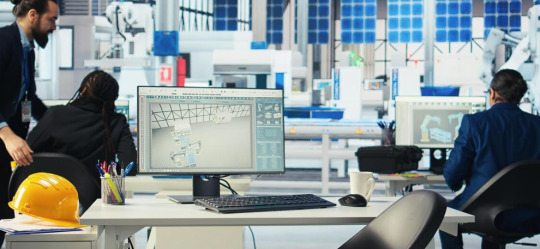
0 notes
Text
Unlocking the Power of MikroTik Router for Advanced Networking
In today’s connected world, a reliable and flexible network is vital for both homes and businesses. One of the most popular choices for advanced yet affordable network management is the MikroTik Router. Known for its powerful performance, versatility, and cost-effectiveness, MikroTik has become a go-to brand for network professionals, system integrators, and tech-savvy home users alike.

Why Choose MikroTik?
MikroTik offers a wide range of products including Cloud Router Switch, POE devices, and RouterBOARD units. Each device runs on RouterOS, MikroTik's proprietary operating system that enables robust network customization. From simple routing tasks to complex traffic shaping and VLAN Setup, RouterOS delivers enterprise-level features at a fraction of the cost.
Whether you're managing a small office or setting up a router for home, MikroTik routers are engineered to scale with your needs. Their wide range of routers and switches ensures seamless integration across various network topologies.
Features That Set MikroTik Apart
1. Advanced VLAN Setup
VLANs (Virtual Local Area Networks) are critical for network segmentation, especially in business environments. MikroTik makes VLAN setup straightforward through RouterOS, allowing administrators to isolate traffic and enhance network security with minimal configuration.
2. Powerful Firewall Rules
Security is a top concern in any network. MikroTik routers include comprehensive firewall rules that help control inbound and outbound traffic. You can create custom rules to block unwanted connections, prevent DDoS attacks, and safeguard sensitive data.
3. Effortless Port Forwarding
Need to access a server or camera remotely? Port forwarding on MikroTik routers is quick and efficient. With a few settings in RouterOS, you can open specific ports and control traffic direction without compromising network security.
4. Reliable Firmware Update
Frequent firmware updates keep your MikroTik devices secure and efficient. Updates often include performance enhancements, bug fixes, and new features that extend the functionality of your router or switch.
5. Versatile POE Support
For those using IP cameras or VoIP phones, MikroTik’s POE support (Power over Ethernet) simplifies device setup by combining power and data over a single cable. This reduces clutter and minimizes the need for additional power adapters.
Comparing MikroTik vs Ubiquiti
A common debate in networking circles is MikroTik vs Ubiquiti. While both brands offer robust networking solutions, MikroTik excels in customization and cost-effectiveness. Ubiquiti may offer a more user-friendly interface, but MikroTik stands out for users who want deeper control and scriptable configurations.
For advanced users or network engineers, MikroTik is often preferred due to the flexibility of RouterOS and the sheer variety of available tools. Whether it’s traffic control, bandwidth management, or setting up firewall rules, MikroTik provides granular control unmatched by most competitors.
Ideal Use Cases
MikroTik routers and switches are used across various industries including telecom, education, hospitality, and enterprise IT. Even as a router for home, MikroTik delivers far more functionality than traditional consumer-grade equipment. With advanced features like VLAN setup, port forwarding, and firewall rules, users can enjoy enterprise-grade performance at home.
If you're deploying a network with multiple access points, the Cloud Router Switch series provides excellent backbone support. Combine that with RouterBOARD for specialized applications and you have a complete network solution tailored to your needs.
Conclusion
Whether you're building a network from the ground up or upgrading your existing infrastructure, a MikroTik Router offers unmatched value and capability. With features like RouterOS, POE, firmwareupdates, and flexible switches, MikroTik is ideal for both beginners and professionals. From router for home to enterprise networking, MikroTik delivers reliable, scalable, and secure solutions.
0 notes
Text
Top 5 Reasons to Upgrade to a PoE Switch for Your Office Network
Simplify Cabling with Power and Data Over One Cable
Upgrading to a PoE switch simplifies your office network by delivering both power and data through a single Ethernet cable.
This dual functionality reduces the need for separate power outlets and extra wiring, minimizing cable clutter and making installations faster and cleaner.
It’s especially helpful in modern offices where devices like IP phones, wireless access points, and security cameras need flexible placement.
By cutting down on cables and power adapters, PoE streamlines network setup and maintenance, creating a more organized workspace and reducing potential points of failure, which ultimately improves efficiency and saves time and money.
Flexible Device Placement Anywhere in the Office
One of the biggest advantages of PoE switches is the ability to place network devices anywhere in the office, regardless of nearby power sources.
Devices like IP phones, security cameras, and Wi-Fi access points can be installed in optimal locations for coverage and performance without worrying about electrical outlets.
This flexibility is especially valuable in large or open office spaces, historic buildings, or areas where adding power wiring is difficult or costly.
PoE ensures reliable power delivery through Ethernet cables, empowering businesses to design smarter, more efficient networks that adapt easily to changing workspace layouts.
Cost Savings on Installation and Maintenance
Upgrading to PoE switches can lead to significant cost savings for businesses by eliminating the need for additional electrical wiring and separate power supplies for each device.
Since power and data travel through the same Ethernet cable, installation becomes quicker and less labour-intensive, reducing upfront setup costs.
Maintenance is also simplified, as fewer cables and power adapters mean fewer potential points of failure and easier troubleshooting.
Over time, these savings add up, especially in larger offices with numerous connected devices. PoE technology offers an economical and efficient way to power your network while minimizing both installation and ongoing maintenance expenses.
Enhanced Network Management and Security
Managed PoE switches provide advanced control and monitoring capabilities that improve both network performance and security.
With these switches, IT teams can easily oversee power usage, prioritize traffic, and remotely manage connected devices like IP phones and cameras. This level of control helps quickly identify and resolve issues, minimizing downtime.
Additionally, managed PoE switches offer enhanced security features such as VLAN segmentation, access control, and real-time threat detection, protecting sensitive office data and connected devices from cyber threats.
Overall, they give businesses greater visibility and protection, ensuring a more reliable and secure network environment.
Future-Proof Your Office with Scalable Technology
PoE switches offer a scalable solution that grows with your office’s evolving technology needs.
As businesses add more smart devices—such as IP cameras, VoIP phones, and Wi-Fi access points—PoE infrastructure easily supports increased power and data demands without the need for costly rewiring or electrical upgrades.
This flexibility allows offices to quickly adapt to changing workspace layouts or expanding teams.
Investing in PoE technology now ensures your network remains robust and ready for future innovations, helping your business stay competitive and efficient while minimizing disruptions and expenses related to infrastructure changes.
0 notes
Text
Ranked 5 stars at 110,000. Critics of the 5 Ethernet Switch Gigabit from TP-LINK is almost free.
There are many brands in Amazon that are close to the satisfaction of the perfect customer and TP-LINK is one of the top 4 or 5 brands that are regularly commented on the outdoing.– Now, one of their leading sellers – Switch 5 -port Gigabit Ethernet – There is a lot of discounts in a limited time (while the supply has a lifetime) Only more products 110,000 criticism at rank 5/5 Which can be said…
0 notes
Text
Ranked 5 stars at 110,000. Critics of the 5 Ethernet Switch Gigabit from TP-LINK is almost free.
There are many brands in Amazon that are close to the satisfaction of the perfect customer and TP-LINK is one of the top 4 or 5 brands that are regularly commented on the outdoing.– Now, one of their leading sellers – Switch 5 -port Gigabit Ethernet – There is a lot of discounts in a limited time (while the supply has a lifetime) Only more products 110,000 criticism at rank 5/5 Which can be said…
0 notes